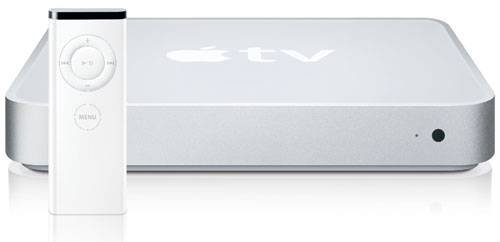Hosted by site sponsor WebMate.
Apple TV Q&A
Update Published May 25, 2021
Also see: All Apple Q&As >> Apple TV Q&A (Home)
To be notified of new Q&As, sign up for EveryMac.com's bimonthly email list.
What exactly is Apple TV? Is it a television? Is it a Mac?
Please note that this Q&A specifically refers to the original Apple TV which was discontinued on September 1, 2010. For information on the current Apple TV models, see "What are all the differences between the current Apple TV HD and Apple TV 4K models? Which should I buy?"
Judging from e-mails received, one potential disadvantage of the decision to release the final product as "Apple TV" rather than the codename of "Apple iTV" is that some new users asked why Apple had decided to sell a television.
Despite the name, Apple TV is not a television. It uses software similar to the MacOS X application Front Row -- and runs a scaled down version of "OS X" -- but it was not designed to run the gamut of MacOS X software, and consequently, it is not a Mac either.
The original Apple TV is a simple, compact -- 1.1 inches tall, 7.7 inches wide, and 7.7 inches deep -- "set top box" that makes it possible to wirelessly "stream" iTunes content -- "music, audiobooks, videos, TV shows, and movies" -- from as many as five Macs or PCs to an enhanced-definition or high-definition TV (and as of January 15, 2008, rent movies directly). It officially works with EDTV or HDTV sets with HDMI or component video and audio ports, but it also works with a limited number of SDTV sets.

Photo Credit: Apple, Inc.
On the Apple website, the company originally explained:
Say you've just downloaded Cars from iTunes. Instead of huddling around your computer to watch, you pop some popcorn while your computer wirelessly syncs your new flick to Apple TV. Then you pull up a seat, put up your feet, and pick up the included Apple Remote to play your movie on TV. Give yourself a hand: You've just changed the way you watch digital media.
On January 15, 2008, Apple added new software that also makes it possible to rent movies directly from the television using the Apple TV.
Apple reports that the original internal 40 GB hard drive can hold up to 50 hours of movies and TV shows (at H.264 1.5-Mbps video at 640x480 with 128-Kbps audio, 720p maximum), up to 9,000 songs (assuming songs are 4 minutes long and encoded in 128-Kbps AAC), and up to 25,000 "Apple TV viewable photos transferred from iTunes". Apple likewise reports that the Apple TV released with a 160 GB hard drive on May 30, 2007 holds up to 200 hours of video, up to 36,000 songs, or up to 25,000 photos using the same formats.
The original Apple TV does not play CDs or DVDs nor does it allow one to record from television. However, for those accustomed to purchasing movies and television programs through the iTunes Store, the Apple TV did make it convenient to watch this content on a television, as well as most other content stored in iTunes. Starting on January 15, 2008, the original Apple TV also provided an inexpensive "pay-per-view" option to rent movies directly from the television.
On May 25, 2018, Apple stopped supporting the original Apple TV in iTunes.
Permalink | Report an Error/Typo | Sign Up for Site Update Notices
Established in 1996, EveryMac.com has been created by experts with decades of experience with Apple hardware. EveryMac.com includes, and always has included, original research incorporating detailed, hands-on inspection of packaging, computers, and devices as well as extensive real-world use. All information is provided in good faith, but no website or person is perfect. Accordingly, EveryMac.com is provided "as is" without warranty of any kind whatsoever. EveryMac.com, and the authors thereof, shall not be held responsible or liable, under any circumstances, for any damages resulting from the use or inability to use the information within. For complete disclaimer and copyright information please read and understand the Terms of Use and the Privacy Policy before using EveryMac.com. Copying, scraping, or use of any content without expressed permission is not allowed, although links to any page are welcomed and appreciated.
